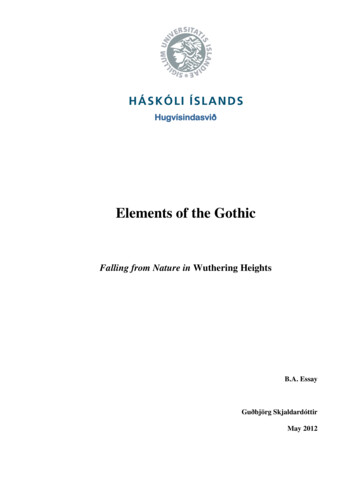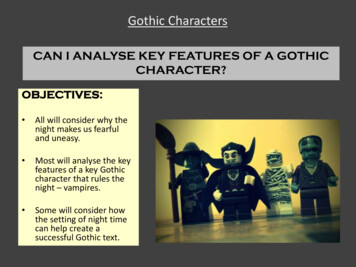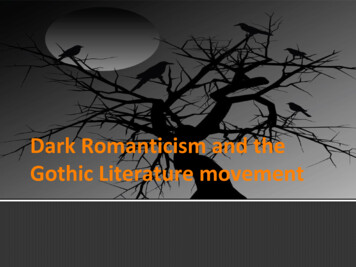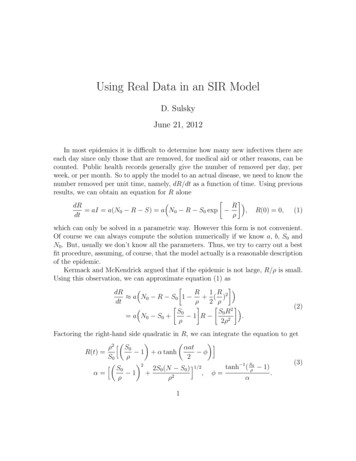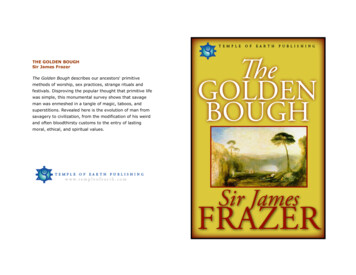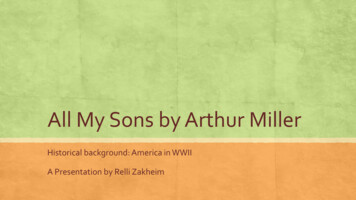
Transcription
GOTHIC ELEMENTS IN SIR ARTHUR CONAN DOYLE’SSHERLOCK HOLMES STORIESA THESIS SUBMITTED TOTHE GRADUATE SCHOOL OF SOCIAL SCIENCESOFMIDDLE EAST TECHNICAL UNIVERSITYBYMURAT ÇAĞLIYANIN PARTIAL FULFILLMENT OF THE REQUIREMENTSFORTHE DEGREE OF MASTER OF ARTSINTHE DEPARTMENT OF ENGLISH LITERATUREDECEMBER 2010
Approval of the Graduate School of Social SciencesProf. Dr. Meliha AltunışıkDirectorI certify that this thesis satisfies all the requirements as a thesis for the degree ofMaster of Arts.Prof. Dr. Wolf KönigHead of DepartmentThis is to certify that we have read this thesis and that in our opinion it is fullyadequate, in scope and quality, as a thesis for the degree of Master of Arts.Assist. Prof. Dr. Margaret SönmezSupervisorExamining Committee Members(METU, FLE)Assist. Prof. Dr. Margaret Sönmez (METU, FLE)Assoc. Prof. Dr. Joshua BearDr. Berkem Gürenci Sağlam(Başkent U., AMER)
I hereby declare that all information in this document has been obtained andpresented in accordance with academic rules and ethical conduct. I alsodeclare that, as required by these rules and conduct, I have fully cited andreferenced all material and results that are not original to this work.Name, Last name : Murat ÇAĞLIYANSignatureiii:
ABSTRACTGOTHIC ELEMENTS IN SIR ARTHUR CONAN DOYLE’SSHERLOCK HOLMES STORIESÇağlıyan, MuratM.A., Department of English LiteratureSupervisor: Assist. Prof. Dr. Margaret SönmezDecember 2010, 102 pagesThe aim of this thesis is to analyse the use of Gothic elements in Sir Arthur ConanDoyle’s Sherlock Holmes stories. It begins with an overview of Gothic anddetective fiction, pointing out the Gothic novels published in the late Victorianperiod, and referring to the Gothic influence on Poe, Dickens, and Collins who areimportant writers in the development of detective fiction. In this way, it isrevealed that the presence of Gothic elements in the Sherlock Holmes stories ispart of the writing fashion of the era. The thesis then analyses the Holmes storieswhich present significant Gothic elements in terms of terror, horror and thesupernatural. In addition, it examines the whole Holmes canon in an endeavour tofind out the Sherlock Holmes character’s similarity to the Byronic hero who oftenappears in Gothic fiction. As a result, this study shows that Gothic elementscontribute to the Sherlock Holmes stories in two ways. Firstly, they add to thedepiction of minor characters, the setting, and the atmosphere of these stories.iv
Secondly, they manifest themselves in the portrayal of the character of Holmeshimself. Thus, the use of Gothic elements enables Doyle to create suspenseful andsurprising stories with a strikingly memorable detective figure.Keywords: Sherlock Holmes, Gothic, Supernatural, Byronic Hero, Doylev
ÖZCONAN DOYLE’UN SHERLOCK HOLMES HĐKAYELERĐNDEGOTĐK ÖĞELERÇağlıyan, MuratYüksek Lisans, Đngiliz Edebiyatı BölümüTez Yöneticisi: Yrd. Doç. Dr. Margaret SönmezAralık 2010, 102 sayfaBu tezin amacı, Conan Doyle’un Sherlock Holmes hikayelerindeki Gotik öğelerinkullanımını incelemektir. Tez, Gotik ve dedektif kurgularının genel birdeğerlendirmesiyle başlar; Victoria döneminin sonlarına doğru yayınlanan Gothicromanlara ve dedektif hikayelerinin gelişmesinde önemli rol oynayan Poe,Dickens ve Collins gibi yazarların eserlerine değinir. Böylece Sherlock Holmeshikayelerindeki Gotik öğelerin varlığının, dönemin yazın modasının bir parçası,hatta bir sonucu olduğu ortaya çıkar. Tez bundan sonra Gotik öğelerin kullanımıaçısından öne çıkan Holmes hikayelerini dehşet, korku ve doğaüstü yönleriyleanaliz eder. Ayrıca, Sherlock Holmes karakterinin Gotik eserlerde çok sık yer alanByronik kahramana benzerlikleri de incelenir. Sonuç olarak bu çalışma, Gotiköğelerin Sherlock Holmes hikayelerine iki şekilde katkıda bulunduğunu gösterir.Đlk olarak Gotik öğeler, yan karakterlerin, mekanların ve atmosferin tasvirine etkivi
eder ve böylece Doyle’un hem gerilimli hem de şaşırtıcı hikayeler yazmasınaolanak sağlar. Đkinci olarak ise, Holmes karakterinin kendisine katkıda bulunarakDoyle’un dikkat çekici biçimde akılda kalan bir dedektif karakteri yaratmasınımümkün kılar.Anahtar Kelimeler: Sherlock Holmes, Gotik, Doğaüstü, Byronik Kahraman,Doylevii
To My Sisterviii
ACKNOWLEDGEMENTSFirst and foremost, I owe my deepest gratitude to my supervisor Assist. Prof. Dr.Margaret Sönmez who has supported me throughout every stage of this thesiswith her invaluable guidance, inspiring discussions, positive feedback andceaseless encouragement.I am also grateful to the examining committee members Assoc. Dr. Joshua Bearand Dr. Berkem Gürenci Sağlam for their constructive comments and helpfulsuggestions which significantly contributed to the preparation of this thesis.I would like to express my sincere thanks to Çiçek Sünbül for her friendship,constant support and selfless help during the course of this study. I would also liketo thank Kohei Imai, a great friend who has always shown unwavering belief inme and encouraged me since I started to work on this thesis. I am also thankful toDavid Tovell for his genuine interest in my thesis and for constantly inspiring meas he has had the opportunity to take part in a Sherlock Holmes film. Anotherfriend whom I would like to thank is Ingrid Massoud whose suggestions helpedme greatly in the course of my research in writing this thesis. My special thanksgoes to Pınar Aydın for always cheering me up whenever I needed it the most.Finally, I am grateful to my sister for always being beside me. Her encouragement,love and understanding have really made this process enjoyable. I would also liketo extend my thanks to my parents for their continuing love and support.ix
TABLE OF CONTENTSPLAGIARISM.iiiABSTRACT.ivÖZ.viDEDICATION . . .viiiACKNOWLEDGEMENTS.ixTABLE OF CONTENTS.xCHAPTER1. INTRODUCTION.12. TERROR, HORROR AND THE SUPERNATURAL . .202.1 “The Adventure of the Speckled Band”.252.2 “The Adventure of the Copper Beeches”.352.3 “The Adventure of the Yellow Face”.492.4 The Hound of the Baskervilles.553. SHERLOCK HOLMES AS A BYRONIC HERO.714. CONCLUSION.93REFERENCES.96x
CHAPTER 1INTRODUCTIONThe term “Gothic” historically refers to the Goths, one of severalGermanic tribes that had a significant role in the fall of the Roman Empire in thefourth century. As a literary term, “Gothic” is applied to a certain type of fictionwhich is considered to have begun in 1764 with the publication of the novel, TheCastle of Otranto. Written by Horace Walpole, this novel was interestinglysubtitled “A Gothic Story”, although the word “Gothic” implied its medievalsetting because “Gothic” signified “the medieval” in the eighteenth century(Stevens 9).“Gothic” as a literary term is in fact “mostly a twentieth-century coinage”(Clery 21). In the Renaissance period, this term started to be used for themedieval-style architecture built from the twelfth to the sixteenth centuries. In themid-eighteenth century, Gothic Revival emerged in architecture in England,which was related to a similar taste in this writing tradition, since originally theseworks presented medieval settings and superstitions (Clery 21).After its publication, The Castle of Otranto became a popular work,inspiring and influencing many writers of its period. Thus many novels presentingsimilar features were published, and these works are now regarded as early Gothicnovels. “[T]he first phase of gothic fiction” took place between the 1760s and the1820s (Pykett 195). Among the most well-known early Gothic novels are Clara1
Reeve’s The Old English Baron (1778), Ann Radcliffe’s The Mysteries ofUdolpho (1794), also The Italian (1797), Matthew Lewis’s The Monk (1796),Mary Shelley’s Frankenstein (1818), and Charles Maturin’s Melmoth theWanderer (1820).Common elements of these Gothic works established the stockcharacteristics of Gothic fiction. Pykett describes these characteristics in this way:Although very different in style and emphasis these novels share apenchant for mysterious, archaic settings, which include isolated andpossibly haunted castles, dungeons, or sublime landscapes. They alsoshare a preoccupation with the monstrous and supernatural, and makefrequent use of dreams, visions, hallucinations, metamorphoses ofvarious kinds, and, in some cases [ ] the psychological splitting ordoubling of characters. Their plots turn variously on dynastic ambitionand intrigue, and Faustian overreaching, and they frequently involveviolence, tyranny, imprisonment, and persecution (especially ofwomen). (Pykett 195)Botting argues that “[t]ortuous, fragmented narratives relating mysteriousincidents, horrible images and life-threatening pursuits predominate in theeighteenth century” (Botting 2). He also lists some stock characters of earlyGothic fiction although they do not necessarily appear in every Gothic story. Heclaims: “Spectres, monsters, demons, corpses, skeletons, evil aristocrats, monks2
and nuns, fainting heroines and bandits populate Gothic landscapes as suggestivefigures of imagined and realistic threats” (Botting 2).Gothic hero-villains are also one of the stock characters of Gothic fiction.Fiedler discusses the hero-villain and argues that he “is indeed an invention of thegothic form, while his temptation and suffering, the beauty and terror of hisbondage to evil are amongst its major themes” (qtd. in Stoddart 176). The Byronichero who is one of the “subclasses of villains [which] illustrate the complexitiesof Gothic characterization” (Snodgrass 351), also appears in Gothic fiction. “Themost enigmatic of villains, the Byronic hero, is an ambiguous, quasi-demonicmale figure whose aloofness and secretive, cynical behavior project sexual allureand a mystic renown” (Snodgrass 351).Concerning settings of early Gothic fiction, the castle stands out. Bottingmaintains that[t]he major locus of Gothic plots, the castle, was gloomilypredominant in early Gothic fiction. Decaying, bleak and full ofhidden passageways, the castle was linked to other medievaledifices—abbeys, churches and graveyards especially— that, in theirgenerally ruinous states, harked back to a feudal past associated withbarbarity, superstition and fear. (Botting 2-3)Around the 1790s, a “Gothic craze” can be observed in England (Miles 42).“From 1788 until 1807 the Gothic maintains a market share of around 30 percent3
of novel production, reaching a high point of 38 percent in 1795” (Miles 42).David Stevens argues that the reason for the popularity of Gothic fiction ineighteenth-century England is the Gothic’s dependance on feelings and emotionsrather than rationality. He suggests that[t]he 18th century was in many ways the high point of theEnlightenment, especially in Britain. In historical terms the medievalperiod pre-dated the Enlightenment, just as in terms of the growth ofeach individual person the emotions come before and can therefore beseen as more profoundly human than the insistence on rationality. Atthe same time, social progress, relying largely on more and morerationally based political and social organisation and on variousscientific and technological inventions, had made it comparatively‘safe’ to indulge in irrational fantasies. Middle class readers, safelytucked into their stable and unthreatened social positions, could feelsecure enough to cultivate imaginary fears and fantasies, in the sameway that a child may do, reading horror stories and experiencing thedelicious thrill while apparently immune from real danger. (Stevens10)Gothic works provides the eighteenth-century reader with a kind of escape fromthe rational world to the superstitious past, and they give them the pleasure ofexperiencing “[t]he play between rational and irrational” (Spooner 254) in their4
reason-dominated life. Snodgrass further suggests: “The passage of a series ofsuspenseful events toward the rescue of a heroine and/or the redemption of a heroproved more satisfying than did an ordinary uneventful life” (Snodgrass 156).The first-wave of Gothic fiction came to an end in 1820 (Luckhurst ix).Charles Maturin's Melmoth the Wanderer (1820) is regarded as the last Gothicnovel of the first wave. However, the Gothic did not completely disappear fromthe literary scene. Rather, it scattered its elements into Victorian fiction, as RogerLuckhurst argues while discussing the period after the end of the first-wave:“[T]he furniture of the Gothic was then dispersed, placed here and there in thenooks and crannies of the Victorian house of fiction” (Luckhurst ix). As a resultof this, Gothic influence can be traced in the works of famous Victorian writerssuch as Dickens and the Brontës. Some of their works which stand out in thisrespect are Dickens’s novels Oliver Twist (1838), A Christmas Carol (1843),Bleak House (1853), and Great Expectations (1861); Emily Brontë’s WutheringHeights (1847), Charlotte Brontë’s Jane Eyre (1847) and Anne Brontë’s TheTenant of Wildfell Hall (1848).In the late nineteenth century, the Gothic returned in an intensified way, asLuckhurst says: “[T]he Gothic rematerialized in the late-Victorian period as adistinct form again, producing enduring Gothic icons in a few short years”(Luckhurst ix). Botting also argues: “At the end of the nineteenth century familiarGothic figures—the double and the vampire—re-emerged in new shapes, with adifferent intensity and anxious investment as objects of terror and horror” (Botting135). Among the most significant Gothic works belonging to the second-wave in5
the late Victorian period are Robert Louis Stevenson’s Dr. Jekyll and Mr. Hyde(1886), Oscar Wilde’s The Picture of Dorian Gray (1890), H.G. Wells’s TheIsland of Dr. Moreau (1896) and Bram Stoker’s Dracula (1897).Botting argues that the “list [of characters in Gothic fiction] grew, in thenineteenth century, with the addition of scientists, fathers, husbands, madmen,criminals and the monstrous double signifying duplicity and evil nature” (Botting2). The setting also changes in this wave, as Botting puts it: “In later fiction, thecastle gradually gave way to the old house: as both building and family line, itbecame the site where fears and anxieties returned in the present” (Botting 3).The Gothic also has a noteworthy influence in American fiction. Smitheven advocates that “American fiction began in the Gothic mode, because the firstsubstantial American efforts in fiction coincided with the great period of British[ ] gothic” (Smith 267). “Charles Brockden Brown, the first native-bornAmerican professional writer, occupies an important position in regard totransformations in Gothic writing” (Botting 115). Brown’s four novels, publishedbetween 1798 and 1800, contain Gothic traces. Furthermore, in the works ofWashington Irving, Nathaniel Hawthorne, Herman Melville and Henry James, theGothic influence can be observed. One of the most significant writers in terms ofthe Gothic in America is Edgar Allan Poe. He “is justly famous for Gothic talesthat focus on the dark side of human nature” (Lee 369), and his short stories “TheFall of the House of Usher” (1839), “The Tell-Tale Heart” (1843), “The Raven”(1845) and “The Cask of Amontillado” (1846) can be given as examples of hisworks containing Gothic elements. In addition, Charlotte Perkins Gilman’s “The6
Yellow Wallpaper” (1892), and the works of William Faulkner and AmbroseBierce are also regarded as significant in American Gothic fiction.Concerning England, the second Gothic wave which took place in the latenineeteenth century, could also be observed in the twentieth century, as Luckhurstsuggests: “This wave of the Gothic extended some way into the twentieth centurybefore dispersing again” (Luckhurst ix). Botting claims:Much of the writing linked to Gothic in the early part of the twentiethcentury is carried over from later nineteenth-century styles. Objects ofanxiety take their familiar forms from earlier manifestations: cities,houses, archaic and occult pasts, primitive energies, derangedindividuals and scientific experimentation are the places from whichawesome and inhuman terrors and horrors are loosed on anunsuspecting world. (Botting 158)Joseph Conrad’s Heart of Darkness (1902) and Daphne Du Maurier’s Rebecca(1938) are some of the works that reflect Gothic conventions. Gothic influencealso continued in American fiction with works like H. P. Lovecraft’s “The Call ofCthulhu” (1928). In the twentieth century, with the emergence of cinema, manyGothic works were also made into films. James Whale's Frankenstein (1931), TodBrowning's Dracula (1931), and Alfred Hitchcock’s Rebecca (1940) are based onGothic texts. Luckhurst further maintains that “many date a third wave from the7
‘horror’ boom of the 1970s, with Stephen King, James Herbert, and a rash ofHollywood B-movies reinventing the genre once more” (Luckhurst ix).Thus, it can be said that Gothic fiction “for about 250 years [.] has notjust survived but insisted on coming back repeatedly” (Luckhurst ix). At the endof the twentieth century, works which present Gothic elements, such as SusanHill’s The Woman in Black (1983) and Toni Morrison’s Beloved (1987), were stillappearing. Botting argues that the Gothic is still observable in fiction, as he writes: Gothic writing remains fascinated by objects and practices that areconstructed as negative, irrational, immoral and fantastic. In a worldwhich, since the eighteenth century, has become increasingly secular,the absence of a fixed religious framework as well as changing socialand political conditions has meant that Gothic writing, and itsreception, has undergone significant transformations. Gothic excesses,none the less, the fascination with transgression and the anxiety overcultural limits and boundaries, continue to produce ambivalentemotions and meanings in their tales of darkness, desire and power.(Botting 2)In the twenty-first century, the Gothic preserves its popularity. Works containingGothic elements, like J. K. Rowling’s massively popular Harry Potter series(1997-2007) and Stephenie Meyer’s Twilight saga (2005-2008), are still publishedand widely read. It is also possible to observe Gothic influence in films of the late8
twentieth and twenty-first centuries. With late-twentieth-century films such asCameron’s The Terminator (1986), Branagh’s Mary Shelley’s Frankenstein(1994), and Reiner’s Misery (1990) which is based on Stephen King’s novel of thesame title; and with twenty-first-century films such as Gore Verbinski’s The Ring(2002), Craig Rosenberg’s Half Light (2006), Christopher Nolan’s Batman: TheDark Night Returns (2008), the continuing Harry Potter films (2001-2010), andthe first three films of the Twilight saga (2008-2010), the Gothic continues toappear in both literary works and films today. It should also be noted that manySherlock Holmes films including Guy Ritchie’s Sherlock Holmes (2009) containnoteworthy Gothic elements, which show a continuing recognition of the presenceof the Gothic in Doyle’s Sherlock Holmes stories.As for detective fiction, it is a genre that is usually considered to havedeveloped in the Victorian Period (Thomas 170). Detective fiction is a little hardto define since it often overlaps with crime fiction. Rzepka notes: “If the term‘crime fiction’ is a bit vague, ‘detective fiction’ is downright slippery. We aretempted, initially, to place the latter under the voluminous umbrella of the former.But crime fiction itself seems to straddle some gaping generic divides” (Rzepka 2).However, by referring to Behling’s and Cawelti’s arguments, it is possible todistinguish between these two genres: while “[c]rime narratives, the larger genericcategory into which detective fiction is a subset, detail the commission of a crime,which may range from physical assault to theft to psychological exploitation, itsinvestigation, and then an eventual outcome or judgment” (Behling 32), “[a]s Poedefined it, the detective story formula centers upon the detective’s investigation9
and solution of the crime” (Cawelti 81), which is relevant to the Sherlock Holmesstories.Edgar Allan Poe is generally considered to be “the father of the detectivestory” (Davies, Study vii), and his “The Murders in the Rue Morgue” (1841) isusually regarded as the first modern detective story (Thomas 172). Lee suggests:. [I]f anyone can be taken to be the inventor of detective fiction, it isPoe, whose crime-solving protagonist, C. Auguste Dupin, appears inthree short stories – “The Murders in the Rue Morgue” (1841), “TheMystery of Marie Roget” (1842–3), “The Purloined Letter” (1844).Written before the word “detective” was coined in 1847, what Poecalled his “tales of ratiocination” established a new form of crimefiction. (Lee 369-370)These stories are centred on “a mystery based in the problem of distinguishing thesuspect’s nationality, and that the mystery should be solved by the detective’s useof forensic evidence to identify the suspect as someone or something” (Thomas172). Dupin as a detective “is adept not only at investigation but also atscholarship” (Snodgrass 97). He “merges brilliance and personal eccentricities toadvantage, particularly his yen for solitude and for retracing the thought patternsof criminals” (Snodgrass 98). He “exemplifies the importance of emotionaldetachment and high levels of concentration in the solving of baffling crimes”(Snodgrass 98).10
Martin A. Kayman argues:Because the appearance of Poe’s short stories coincides with thecreation of the ‘Detective Department’ of the Metropolitan Police(1842), detective fiction is seen by many critics as a literary reflectionof, if not propaganda for, a new form of social administration andcontrol based on state surveillance. (Kayman 44)The development of detective stories in England also corresponds “in time to theintroduction of the modern police force in England and to the invention of thescience of criminology” (Thomas 171).“The originator of the detective story in Britain” is regarded as CharlesDickens (Thomas 172). Published in 1853, Dickens’s Bleak House features apolice inspector called Mr. Bucket who “is one of the first detectives in Englishfiction, ancestor of Conan Doyle’s Sherlock Holmes” (Tropp 73). In this novel,Bucket “solves one murder, uncovers another mystery, and leads his charactersthrough the darkest corners of Victorian London” (Tropp 73).Another important text which is regarded as significant in the developmentof the detection genre in England is Wilkie Collins’s The Moonstone (1868). Withthe character “Sergeant Cuff, The Moonstone offers one of the great literarydetectives in the genre” (Thomas 183). Ronald R. Thomas points out that11
[h]is [Sergeant Cuff’s] keen powers of observation, his uncannyjudgment of character, and his acute deductive reasoning impresseveryone when he discovers a crucial, overlooked piece of evidence atthe scene of the crime. Nevertheless, these talents are not adequate inbringing the case to a close. [ ] The attorney Mr. Bruff plays anessential part in solving the mystery as well, but is also not adequateto the task. (Thomas 183)In this novel, “the mystery is solved not by the legal expertise of an attorney noreven by the ingenious detective, but by the diagnostic brilliance of a physician”(Thomas 183). In this way, the image of the physician is also brought closer to theimage of the detective, as Thomas advocates:[T]he rise of the scientific expertise of the medical profession isshown to be both collaborative and competitive with that of the legalprofession, a development that corresponded to the emergence ofcriminology and forensic science as important new disciplines in thetreatment of crime and to the establishment of detective fiction as adistinct and popular literary genre. (Thomas 183)Thus, Bleak House and The Moonstone play important roles in the development ofdetective fiction in England. Thomas claims: “There would be other contributionsto Victorian detection before Sherlock Holmes appeared, though none would as12
significantly influence the shape of Victorian writing or approach his level ofpopularity” (Thomas 184).Detective fiction was truly established as a distinct genre with thepublication of the Sherlock Holmes stories. In 1887, Sir Arthur Conan Doyle’sfirst Sherlock Holmes novel, A Study in Scarlet was published in the Beeton’sChristmas Annual. The second Holmes novel, The Sign of Four was published in1890, after which the Holmes figure became popular. Then Doyle started to writea series of Holmes short stories for the Strand Magazine, starting from 1891.Sherlock Holmes is a brilliant consulting detective, famous for his specialintellectual abilities and powers of deductive reasoning. He shares rooms with Dr.John Watson who generally accompanies him on his investigations and publishesaccounts of them. The Sherlock Holmes body of works contains fifty six shortstories and four novels, published between 1887 and 1927. The novels are A Studyin Scarlet (1887), The Sign of Four (1890), The Hound of the Baskervilles (1902),and The Valley of Fear (1915). The Holmes short stories are compiled in booksentitled The Adventures of Sherlock Holmes (1892), The Memoirs of SherlockHolmes (1894), The Return of Sherlock Holmes (1905), His Last Bow (1917), andThe Case-Book of Sherlock Holmes (1927).When Conan Doyle wrote the very first Sherlock Holmes story, he wasworking as an eye-specialist. His aim and sources of influence while creating thecharacter Sherlock Holmes and these stories are discussed by Davies, as givenbelow:13
In the longueurs between the infrequent patients, Doyle consideredwriting a detective story, one in which the sleuth would reach hisconclusions by deductive reasoning and not by accident or thecarelessness of the criminal. It was during these musings that he beganto pull together various threads from past influences. From boyhoodPoe’s Dupin had been one of his heroes. He had also admired ‘the neatdovetailing’ of the plots in Gaboriau’s crime novels. And then therewas Joseph Bell, who had been one of Doyle’s tutors when he wasstudying medicine at Edinburgh University, had the most remarkablepowers of observation. (Davies, Study vii-viii)Doyle talks about his aim in creating the Sherlock Holmes stories in hisautobiographical work, Memoirs and Adventures (1924). Referring to his beinginfluenced by his mentor Joseph Bell, he says that he wanted to “reduce thisfascinating unorganised business to something nearer an exact science” (qtd. inDavies, Study viii), meaning detective work.After some time, Doyle stopped pursuing his medical career owing to thefact that he decided to focus on writing. Later, he killed off Sherlock Holmes in“The Adventure of the Final Problem” (1893), as he wanted to concentrate onwriting serious works. However, in 1901, he brought back Holmes in the novelThe Hound of the Baskervilles: Another Adventure of Sherlock Holmes, due topopular demand. Martin Priestman argues:14
With Doyle’s creation of the Sherlock Holmes series, detective fictionbecame for the first time an indubitably popular and repeatable genreformat. It now knows what it is and what it is trying to do, as does itspublic. (Priestman 4)Kayman also notes that[i]n contrast to the serial publication of long novels, here each tale isself-contained, the detective’s solution providing full narrativesatisfaction, but so managed as to stimulate an appetite for another,similar story – so much so that, notoriously, popular demand andapparently irresistible commercial pressures made it impossible forDoyle to kill Holmes off as he wished in 1893. (Kayman 43)After Holmes stories, detective stories gained in popularity and for more than onehundred years following, very many writers turned to the sub-genre such asAgatha Christie, Dorothy L. Sayers, and P. D. James. Detective fiction as aliterary genre “remains today the most popular form of writing in the Englishspeaking world” (Thomas 190).There have been several critical approaches towards the Gothic throughouthistory. There was a psychoanalytic approach from the 1930s to the 1950s (Sage154). It “gave way to more historical, linguistic and socio-cultural approaches”and “[f]rom the 1960s onwards, the growth of interest in popular culture and the15
rise of feminism have changed and immensely broadened the literary and criticalpossibilities for the Gothic” (Sage 154). In addition, as Horner remarks:The German word unheimlich, meaning ‘uncanny’, is one much usedin criticism of Gothic writing. Its use in this manner derives fromSigmund Freud’s famous essay ‘The “Uncanny”’, published in 1919.In this essay, Freud distinguishes between heimlich, meaning‘familiar’ or ‘belonging to the home’, and unheimlich, meaning allthat is ‘unhomely’, or ‘uncanny’, and is frightening precisely becauseit is not known and not familiar. (Horner 250)There have also been many critics who examined the connection between Gothicand detective fictio
My special thanks goes to Pınar Aydın for always cheering me up whenever I needed it the most. Finally, I am grateful to my sister for always being beside me. Her encouragement, love and understanding have really made this process enjoyable. I would also like to extend my thanks to m
